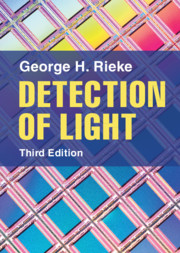
-
Select format
-
- Publisher:
- Cambridge University Press
- Publication date:
- April 2021
- May 2021
- ISBN:
- 9781316407189
- 9781107124141
- Dimensions:
- (244 x 170 mm)
- Weight & Pages:
- 0.83kg, 450 Pages
- Dimensions:
- Weight & Pages:
You may already have access via personal or institutional login
Book description
The invention and development of advanced methods to detect light underlies much of modern technology. This fully updated and restructured third edition is unique amongst the literature, providing a comprehensive, uniform discussion of a broad range of detection approaches. The material is accessible to a broad range of readers rather than just highly trained specialists, beginning with first principles and developing the relevant physics as it goes. The book emphasizes physical understanding of detector operation, without being a catalog of current examples. It is self-contained but also provides a bridge to more specialized works on specific approaches; each chapter points readers toward the relevant literature. This will provide a broad and lasting understanding of the methods for detecting light that underpin so much of our technology. The book is suitable for advanced undergraduate and graduate students, and will provide a valuable reference for professionals across physics and engineering disciplines.
Reviews
‘The book introduces the detection of light and is designed to be accessible to a broad range of readers rather than just highly trained specialists … is an ideal read for master’s and Ph.D. students in astronomical instrumentation.’
Silvano Donati Source: Optics & Photonics News
‘The book is increased in breadth from earlier editions, and now covers the vast majority of the electromagnetic spectrum, from millimetre wavelengths to X-rays … it is undoubtedly authoritative, as expected from a leading practising expert in the field … underlying physics is explained at just the right depth required to understand each type of detector … [and] it gets beyond simplistic, generic descriptions to explain how and why real-world detectors have been refined in design, clarifying the strengths and weaknesses of each modification or increased layer of sophistication … the book could be usefully purchased as ‘technical backup’ by those involved in teaching, say, observational astronomy. It is also pitched at just the right level for masterslevel or postgraduate students pursuing work involving the development of astronomical instrumentation, or indeed any area of physics involving photon detection.’
James S. Dunlop Source: The Observatory
Contents
-
1 - Introduction
pp 1-23 -
-
- You have access
- Export citation
-
Metrics
Full text views
Full text views help Loading metrics...
Loading metrics...
* Views captured on Cambridge Core between #date#. This data will be updated every 24 hours.
Usage data cannot currently be displayed.
Accessibility standard: Unknown
Why this information is here
This section outlines the accessibility features of this content - including support for screen readers, full keyboard navigation and high-contrast display options. This may not be relevant for you.
Accessibility Information
Accessibility compliance for the PDF of this book is currently unknown and may be updated in the future.


